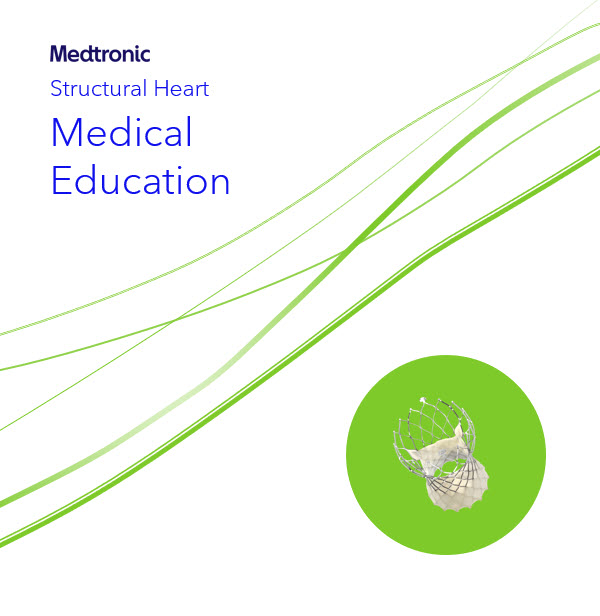Predictability and Control: Evolut procedural approaches and next-gen TAV
Register below
Wednesday, Sept. 28, 2022
7:00 p.m. - 8:00 p.m. CT
Cusp overlap. Commissure alignment. The new Evolut™ FX System.
Join us for the exciting opportunity to hear from key opinion leaders on:
- New data related to TAVR implant techniques
- Evolut procedural approaches
- The next generation Evolut FX TAVR System
Drs. Grubb, Radhakrishnan, Tang, and Yakubov will share their perspectives on implant technique and implications of the data. Hear how Evolut FX is changing the game!

Kendra Grubb, M.D.
Emory Healthcare, Atlanta, GA

Sam Radhakrishnan, M.D.
Schulich Heart Centre, Sunnybrook Health Sciences Centre, University of Toronto, Toronto, Canada

Gilbert Tang, M.D.
Mount Sinai, New York, NY

Steven Yakubov, M.D.
OhioHealth, Columbus, OH
We recommend use of modern browser to register — Chrome, Firefox, or Safari.
*Required field.
The information shared at this event may include Medtronic confidential business information and personal data, including the identity of participants, that is subject to protection under applicable privacy laws and regulations. For these reasons, neither audio recording of this call nor screenshots, photos or videos of the content are permitted, except by the organizers. Please note that your log-in/ID/Name may be seen by others. By registering to participate in this event, you agree to keep Medtronic business information confidential and you consent to the disclosure and use of your log-in/ID/Name and to audio and/or video recording of this event by Medtronic for use at its discretion. Medtronic will comply with applicable privacy laws and regulations and its data privacy policy which is available at https://europe.medtronic.com/xd-en/privacy-statement.html (European Union), https://www.medtronic.com/us-en/privacy-statement.html (United States), https://asiapac.medtronic.com/xp-en/privacy-statement.html (Asia Pacific region), or https://latinoamerica.medtronic.com/xl-es/declaracion-de-privacidad.html (Latin America).
Indications
The Medtronic Evolut™ FX System is indicated for relief of aortic stenosis in patients with symptomatic heart disease due to severe native calcific aortic stenosis who are judged by a heart team, including a cardiac surgeon, to be appropriate for the transcatheter heart valve replacement therapy. The Evolut FX System is indicated for use in patients with symptomatic heart disease due to failure (stenosed, insufficient, or combined) of a surgical bioprosthetic aortic valve who are judged by a heart team, including a cardiac surgeon, to be at high or greater risk for open surgical therapy (e.g., STS predicted risk of operative mortality score ≥ 8% or at a ≥ 15% risk of mortality at 30 days).
Contraindications
The Evolut FX System is contraindicated in patients who cannot tolerate Nitinol (titanium or nickel), gold, an anticoagulation/antiplatelet regimen, or who have active bacterial endocarditis or other active infections.
Warnings
General Implantation of the Evolut FX System should be performed only by physicians who have received Medtronic Evolut FX training. This procedure should only be performed where emergency aortic valve surgery can be performed promptly. Mechanical failure of the delivery catheter system and/or accessories may result in patient complications. Transcatheter aortic valve (bioprosthesis) Accelerated deterioration due to calcific degeneration of the bioprosthesis may occur in: children, adolescents, or young adults; patients with altered calcium metabolism (e.g., chronic renal failure or hyperthyroidism).
Precautions
General Clinical long-term durability has not been established for the bioprosthesis. Evaluate bioprosthesis performance as needed during patient follow-up. The safety and effectiveness of the Evolut FX System have not been evaluated in the pediatric population. The safety and effectiveness of the bioprosthesis for aortic valve replacement have not been evaluated in the following patient populations: Patients who do not meet the criteria for symptomatic severe native aortic stenosis as defined: (1) symptomatic severe high-gradient aortic stenosis — aortic valve area ≤ 1.0 cm2 or aortic valve area index ≤ 0.6 cm2/m2, a mean aortic valve gradient ≥ 40 mm Hg, or a peak aortic-jet velocity ≥ 4.0 m/s; (2) symptomatic severe low-flow, low-gradient aortic stenosis — aortic valve area ≤ 1.0 cm2 or aortic valve area index ≤ 0.6 cm2/m2, a mean aortic valve gradient < 40 mm Hg, and a peak aortic-jet velocity < 4.0 m/s; with untreated, clinically significant coronary artery disease requiring revascularization; with a preexisting prosthetic heart valve with a rigid support structure in either the mitral or pulmonic position if either the preexisting prosthetic heart valve could affect the implantation or function of the bioprosthesis or the implantation of the bioprosthesis could affect the function of the preexisting prosthetic heart valve; patients with liver failure (Child-Pugh Class C); with cardiogenic shock manifested by low cardiac output, vasopressor dependence, or mechanical hemodynamic support; patients who are pregnant or breastfeeding. The safety and effectiveness of an Evolut FX bioprosthesis implanted within a failed preexisting transcatheter bioprosthesis have not been demonstrated. Implanting an Evolut FX bioprosthesis in a degenerated surgical bioprosthetic valve (transcatheter aortic valve in surgical aortic valve [TAV-in-SAV]) should be avoided in the following conditions: The degenerated surgical bioprosthetic valve presents with: a significant concomitant paravalvular leak (between the prosthesis and the native annulus), is not securely fixed in the native annulus, or is not structurally intact (e.g., wire form frame fracture); partially detached leaflet that in the aortic position may obstruct a coronary ostium; stent frame with a manufacturer-labeled inner diameter < 17 mm. The safety and effectiveness of the bioprosthesis for aortic valve replacement have not been evaluated in patient populations presenting with the following: Blood dyscrasias as defined as leukopenia (WBC < 1,000 cells/mm3), thrombocytopenia (platelet count < 50,000 cells/mm3), history of bleeding diathesis or coagulopathy, or hypercoagulable states; congenital unicuspid valve; mixed aortic valve disease (aortic stenosis and aortic regurgitation with predominant aortic regurgitation [3-4+]); moderate to severe (3-4+) or severe (4+) mitral or severe (4+) tricuspid regurgitation; hypertrophic obstructive cardiomyopathy; new or untreated echocardiographic evidence of intracardiac mass, thrombus, or vegetation; native aortic annulus size < 18 mm or > 30 mm per the baseline diagnostic imaging or surgical bioprosthetic aortic annulus size < 17 mm or > 30 mm; transarterial access unable to accommodate an 18 Fr introducer sheath or the 14 Fr equivalent Evolut FX Delivery Catheter System with InLine™ Sheath when using model D-EVOLUTFX-2329 or transarterial access unable to accommodate a 22 Fr introducer sheath or the 18 Fr equivalent Evolut FX Delivery Catheter System with InLine Sheath when using model D-EVOLUTFX-34; prohibitive left ventricular outflow tract calcification; sinus of Valsalva anatomy that would prevent adequate coronary perfusion; significant aortopathy requiring ascending aortic replacement; moderate to severe mitral stenosis; severe ventricular dysfunction with left ventricular ejection fraction (LVEF) < 20%; symptomatic carotid or vertebral artery disease; and severe basal septal hypertrophy with an outflow gradient.
Before Use Exposure to glutaraldehyde may cause irritation of the skin, eyes, nose, and throat. Avoid prolonged or repeated exposure to the vapors. Damage may result from forceful handling of the catheter. Prevent kinking of the catheter when removing it from the packaging. The bioprosthesis size must be appropriate to fit the patient’s anatomy. Proper sizing of the devices is the responsibility of the physician. Refer to the Instructions for Use for available sizes. Failure to implant a device within the sizing matrix could lead to adverse effects such as those listed below. Patients must present with transarterial access vessel diameters of ≥ 5 mm when using model D-EVOLUTFX-2329 or ≥ 6 mm when using model D-EVOLUTFX-34, or patients must present with an ascending aortic (direct aortic) access site ≥ 60 mm from the basal plane for both systems. Implantation of the bioprosthesis should be avoided in patients with aortic root angulation (angle between plane of aortic valve annulus and horizontal plane/vertebrae) of > 30° for right subclavian/axillary access or > 70° for femoral and left subclavian/axillary access. For subclavian access, patients with a patent left internal mammary artery (LIMA) graft must present with access vessel diameters that are either ≥ 5.5 mm when using model D-EVOLUTFX-2329 or ≥ 6.5 mm when using model D-EVOLUTFX-34. Use caution when using the subclavian/axillary approach in patients with a patent LIMA graft or patent RIMA graft. For direct aortic access, ensure the access site and trajectory are free of patent RIMA or a preexisting patent RIMA graft. For transfemoral access, use caution in patients who present with multiplanar curvature of the aorta, acute angulation of the aortic arch, an ascending aortic aneurysm, or severe calcification in the aorta and/or vasculature. If ≥ 2 of these factors are present, consider an alternative access route to prevent vascular complications. Limited clinical data are available for transcatheter aortic valve replacement in patients with a congenital bicuspid aortic valve who are deemed to be at low surgical risk. Anatomical characteristics should be considered when using the valve in this population. In addition, patient age should be considered as long-term durability of the valve has not been established.
During Use After the procedure, administer appropriate antibiotic prophylaxis as needed for patients at risk for prosthetic valve infection and endocarditis. After the procedure, administer anticoagulation and/or antiplatelet therapy per physician/clinical judgment. Excessive contrast media may cause renal failure. Prior to the procedure, measure the patient’s creatinine level. During the procedure, monitor contrast media usage. Conduct the procedure under fluoroscopy. Fluoroscopic procedures are associated with the risk of radiation damage to the skin, which may be painful, disfiguring, and long-term. The safety and efficacy of an Evolut FX bioprosthesis implanted within a transcatheter bioprosthesis have not been demonstrated.
Potential adverse events
Potential risks associated with the implantation of the Evolut FX transcatheter aortic valve may include, but are not limited to, the following: • death • myocardial infarction, cardiac arrest, cardiogenic shock, or cardiac tamponade • coronary occlusion, obstruction, or vessel spasm (including acute coronary closure) • cardiovascular injury (including rupture, perforation, tissue erosion, or dissection of vessels, ascending aorta trauma, ventricle, myocardium, or valvular structures that may require intervention) • emergent surgical or transcatheter intervention (e.g., coronary artery bypass, heart valve replacement, valve explant, percutaneous coronary intervention [PCI], balloon valvuloplasty) • prosthetic valve dysfunction (regurgitation or stenosis) due to fracture; bending (out-of-round configuration) of the valve frame; underexpansion of the valve frame; calcification; pannus; leaflet wear, tear, prolapse, or retraction; poor valve coaptation; suture breaks or disruption; leaks; mal-sizing (prosthesis-patient mismatch); malposition (either too high or too low)/malplacement • prosthetic valve migration/embolization • prosthetic valve endocarditis • prosthetic valve thrombosis • delivery catheter system malfunction resulting in the need for additional recrossing of the aortic valve and prolonged procedural time • delivery catheter system component migration/embolization • stroke (ischemic or hemorrhagic), transient ischemic attack (TIA), or other neurological deficits • individual organ (e.g., cardiac, respiratory, renal [including acute kidney failure]) or multi-organ insufficiency or failure • major or minor bleeding that may require transfusion or intervention (including life-threatening or disabling bleeding) • vascular access-related complications (e.g., dissection, perforation, pain, bleeding, hematoma, pseudoaneurysm, irreversible nerve injury, compartment syndrome, arteriovenous fistula, or stenosis) • mitral valve regurgitation or injury • conduction system disturbances (e.g., atrioventricular node block, left bundle-branch block, asystole), which may require a permanent pacemaker • infection (including septicemia) • hypotension or hypertension • hemolysis • peripheral ischemia • General surgical risks applicable to transcatheter aortic valve implantation: • bowel ischemia • abnormal lab values (including electrolyte imbalance) • allergic reaction to antiplatelet agents, contrast medium, or anesthesia • exposure to radiation through fluoroscopy and angiography • permanent disability.
Please reference the Evolut FX Instructions for Use for more information regarding indications, warnings, precautions, and potential adverse events.
Caution: Federal Law (USA) restricts these devices to the sale by or on the order of a physician.
The commercial name of the Evolut™ FX device is Medtronic Evolut™ FX System.
medtronic.com
UC202305253 EN ©2022 Medtronic. All rights reserved. Medtronic and the Medtronic logo are trademarks of Medtronic. All other brands are trademarks of a Medtronic company. For distribution in the USA only. 08/2022




